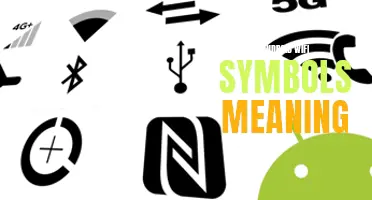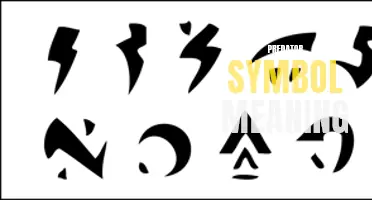
Algebra, often referred to as the language of mathematics, is a powerful tool that enables us to solve problems and understand the world around us. At the heart of algebra lie its symbols and meanings, which serve as the building blocks of mathematical expressions and equations. From the humble letter 'x' representing an unknown quantity to iconic symbols like '+', '-', '*', and '/', each symbol carries its unique meaning and purpose in the vast landscape of algebra. Understanding these symbols and their meanings is essential for mastering the art of algebra and unlocking its potential to uncover hidden truths and patterns in mathematics and beyond.
What You'll Learn
- What is the relationship between algebraic symbols and meanings?
- How do algebraic symbols allow us to manipulate equations and solve for unknowns?
- Can algebraic symbols be used to represent real-world quantities and relationships?
- How do you determine the meaning of a specific algebraic symbol in a given equation or problem?
- Can algebraic symbols have different meanings or interpretations in different contexts?

What is the relationship between algebraic symbols and meanings?
Algebraic symbols are an essential tool in mathematics that represent relationships between quantities. They provide a shorthand way of expressing mathematical ideas and allow us to generalize patterns and relationships. The symbols used in algebra have specific meanings that help us understand the operations and concepts they represent.
In algebra, variables are often used to represent unknown quantities. For example, in the equation 2x + 3 = 9, the variable x represents an unknown number. By using a symbol to represent the unknown quantity, we can easily manipulate equations and solve for the unknown value.
Algebraic symbols also represent mathematical operations such as addition, subtraction, multiplication, and division. For example, the symbol "+" represents addition, and the symbol "-" represents subtraction. These symbols convey meaning and indicate the operation that needs to be performed.
Furthermore, algebraic symbols can represent constants, which are fixed values that do not change. These constants can be represented by specific symbols, such as "π" for the irrational number pi or "e" for the base of the natural logarithm. By assigning symbols to constants, we can write equations that describe mathematical relationships accurately.
The relationship between algebraic symbols and meanings is crucial for understanding and solving mathematical problems. By understanding the meaning behind the symbols, we can manipulate equations, solve for unknown values, and generalize patterns and relationships.
For example, consider the equation 2x + 3 = 9. By understanding that "x" represents an unknown value and that "+" represents addition, we can isolate the variable x and solve for its value. In this case, subtracting 3 from both sides of the equation gives us 2x = 6. Dividing both sides by 2 then allows us to find that x = 3. Understanding the meanings of the symbols in the equation helps us interpret and solve the problem.
Algebraic symbols also allow us to generalize patterns and relationships. By using variables and symbols, we can describe mathematical relationships that hold true for a range of values. This allows us to make predictions and draw conclusions based on the patterns we observe.
In summary, algebraic symbols are a powerful tool in mathematics that represent relationships between quantities. They have specific meanings that convey the operations and concepts they represent. Understanding the meanings of these symbols allows us to manipulate equations, solve for unknown values, and generalize patterns and relationships. The relationship between algebraic symbols and meanings is essential for effectively using algebra to solve mathematical problems.
Understanding the Chemical Symbol 0 0: What Does it Mean?
You may want to see also

How do algebraic symbols allow us to manipulate equations and solve for unknowns?
Algebraic symbols are the key to manipulating equations and solving for unknowns in mathematics. By using symbols to represent numbers and variables, we can create equations that allow us to solve for unknown values.
In algebra, symbols such as x, y, and z are commonly used to represent variables. These variables can be any value or unknown quantity that we want to find. For example, if we want to find the value of an unknown number, we can represent it with the variable x.
Equations are mathematical statements that relate two or more expressions and are composed of two sides separated by an equal sign. The left side of the equation is known as the left-hand side (LHS) and the right side is known as the right-hand side (RHS). By using algebraic symbols, we can write equations in a general form rather than using specific numerical values.
Algebraic symbols allow us to perform various operations on equations, such as addition, subtraction, multiplication, and division. We can manipulate equations by performing the same operation on both sides of the equation. The goal is to isolate the variable we are trying to solve for on one side of the equation.
Let's take an example equation 3x + 5 = 11. Our goal is to solve for x. To isolate x, we need to eliminate the 5 from the equation. We can do this by subtracting 5 from both sides of the equation:
3x + 5 - 5 = 11 - 5
This simplifies to:
3x = 6
Now, to solve for x, we need to get rid of the coefficient 3 in front of the x. We can do this by dividing both sides of the equation by 3:
3x/3 = 6/3
Which simplifies to:
X = 2
By using algebraic symbols, we were able to manipulate the equation and find the value of x.
Algebraic symbols also allow us to solve equations with multiple variables. For example, if we have an equation with two variables, x and y, we can solve for both variables by finding their values simultaneously. This can be done using various algebraic methods such as substitution or elimination.
In conclusion, algebraic symbols are crucial in mathematics as they allow us to manipulate equations and solve for unknowns. By using symbols to represent numbers and variables, we can write equations in a general form and perform operations to isolate the unknown value we want to find. Whether it is a single variable or multiple variables, algebraic symbols provide us with a systematic approach to solving equations and finding solutions.
What Does the Triangle Symbol Mean on My Car? Decoding Common Dashboard Symbols
You may want to see also

Can algebraic symbols be used to represent real-world quantities and relationships?
Algebraic symbols are an essential tool in representing real-world quantities and relationships. In various fields such as physics, engineering, economics, and finance, algebraic symbols serve to translate complex situations into mathematical equations, enabling us to understand, analyze, and solve problems efficiently.
Algebraic symbols, also known as variables, can represent different physical quantities such as time, distance, velocity, acceleration, temperature, pressure, or cost. By assigning variables to these quantities, we can express relationships and make predictions using mathematical equations. For example, in physics, the equation F = ma represents Newton's second law of motion, where F is the force, m is the mass, and a is the acceleration. This equation allows us to calculate the force required to move an object with a given mass and acceleration.
In addition to representing quantities, algebraic symbols can also represent relationships between variables. Let's consider a simple example from economics. Suppose we have a demand function for a product, where the price of the product (P) is inversely related to the quantity demanded (Q) with a constant elasticity of demand (ε). We can represent this relationship algebraically as P = k/Q^ε, where k is a constant. This equation allows us to analyze how changes in price or quantity affect each other, providing valuable insights for businesses and policymakers.
Moreover, algebraic symbols can be used to model real-world phenomena and solve complex problems. For instance, in environmental science, the logistic growth equation is often used to represent population growth. This equation, often written as dN/dt = rN(1 - N/K), where N is the population, t is time, r is the growth rate, and K is the carrying capacity, allows us to understand how a population grows and eventually levels off when it reaches its maximum sustainable size.
Algebraic symbols also enable us to solve equations and make predictions using algebraic operations. By manipulating equations, we can isolate variables, solve for unknowns, and find meaningful solutions. For example, in finance, algebraic symbols are used extensively in interest calculations, mortgage payments, investment analysis, and financial planning. Through algebraic equations, we can determine future values, present values, and the rate of return on investments.
To conclude, algebraic symbols play a crucial role in representing real-world quantities and relationships. They allow us to express complex situations in a concise and precise manner, facilitating analysis and problem-solving. Whether it's calculating forces in physics, understanding demand in economics, modeling population growth in biology, or analyzing financial investments, algebraic symbols are indispensable tools that help us navigate the complexities of the real world.
The Spiritual Meaning Behind the Atom Symbol: Unveiling Its Profound Significance
You may want to see also

How do you determine the meaning of a specific algebraic symbol in a given equation or problem?
In algebra, symbols are used to represent quantities or operations. Understanding the meaning of these symbols is essential for solving equations and problems correctly. Here are some steps to help you determine the meaning of a specific algebraic symbol in a given equation or problem:
- Look for context: Read the problem or equation carefully to understand the context in which the symbol is used. Consider the information provided and any given descriptions or explanations.
- Analyze the equation: Break down the equation or problem into its constituent parts. Identify the different symbols present and determine their roles based on their placement and use.
- Review known symbols: Refer to your knowledge of algebraic symbols that are commonly used and have well-established meanings. These symbols may include basic arithmetic operators (e.g., +, -, ×, ÷) or variables commonly used (e.g., x, y).
- Consult the problem or equation's guidelines: Some equations or problems may provide specific instructions on how certain symbols should be interpreted. Look for any given guidelines or definitions for the symbols within the context of the problem.
- Consider the relationships: Examine the relationships between the symbols and other known quantities or variables in the equation or problem. Determine how they interact and how the unknown symbol relates to other known quantities.
- Apply algebraic principles: Use algebraic principles and properties to find patterns or connections. Look for equations or expressions where the unknown symbol appears and apply algebraic techniques like solving for the unknown or simplifying expressions to gain insight into its meaning.
- Utilize examples or previous knowledge: If the problem relates to a specific concept or mathematical operation, consider examples or previous knowledge of similar problems to help interpret the symbol's meaning. Draw on your experience and try to relate the symbol to familiar situations or contexts.
- Seek assistance if necessary: If you are still unsure about the meaning of a specific symbol, consult a teacher, tutor, or textbook for clarification. Don't hesitate to ask for help or further explanation to ensure you understand the problem properly.
Remember that the meaning of symbols can vary depending on the specific equation or problem. It is important to carefully analyze each situation and utilize the given information to determine the intended meaning of the symbol. With practice and experience, you will become more proficient at interpreting algebraic symbols and using them effectively to solve problems.
The Enchanting Symbolism and Meaning of Pearls
You may want to see also

Can algebraic symbols have different meanings or interpretations in different contexts?
When it comes to the world of algebra, symbols play a vital role in representing mathematical concepts and relationships. These symbols are fundamental tools that allow mathematicians to communicate and manipulate information efficiently. However, one interesting aspect of algebraic symbols is that they can, indeed, have different meanings or interpretations in different contexts.
In a general sense, algebraic symbols are assigned certain meanings based on the context of the problem or equation at hand. For example, the symbol "x" is commonly used to represent an unknown value or variable in algebraic equations. In this context, "x" can be any number that satisfies the given equation. However, in other situations, "x" can also represent a specific value or quantity depending on the problem. This flexibility of interpretation is what makes algebraic symbols powerful and enables their use in a wide variety of mathematical scenarios.
The meaning or interpretation of algebraic symbols can also vary based on the specific branch of mathematics being explored. For instance, in calculus, the symbol "x" may represent a variable that represents a position on a graph or a specific point in a function. In linear algebra, "x" often represents a vector or matrix. In each of these cases, the symbol "x" is given a different meaning and is used in a specific way based on the mathematical context in which it is being used.
Furthermore, the meaning of algebraic symbols can also shift depending on the cultural or regional context in which they are used. Different countries or regions may have different conventions or notations when it comes to algebraic symbols. For example, in some countries, the symbol "x" may be replaced by another symbol such as "α" or "n" to represent a variable or unknown. These variations in notation do not change the underlying mathematical concepts but reflect the different ways in which mathematicians express their ideas.
In addition, algebraic symbols can also take on different meanings or interpretations depending on the field or subject matter being studied. For instance, in physics, the symbol "x" often represents a displacement or position, while in economics, it may represent a quantity or price. These different interpretations of symbols arise due to the specific requirements and conventions within each field.
In conclusion, algebraic symbols can indeed have different meanings or interpretations in different contexts. The context of the problem, the branch of mathematics, the cultural or regional conventions, and the subject matter being studied can all influence the interpretation of algebraic symbols. However, despite these variations, the underlying mathematical concepts remain the same. It is the flexibility and adaptability of algebraic symbols that allow mathematicians to communicate and solve problems effectively across different contexts.
Decoding Porsche Dashboard Symbols: Understanding the Meaning Behind the Signs
You may want to see also
Frequently asked questions
An algebraic symbol is a letter or a combination of letters used to represent a mathematical quantity or variable in algebraic expressions or equations. These symbols can be used to represent unknowns, constants, or any other mathematical object.
In algebraic equations, the symbol "x" is commonly used to represent an unknown value or variable. It is often used when we are trying to solve for a specific value or find the relationship between different variables in an equation.
Similar to "x", the symbol "y" is often used to represent a variable or unknown value in algebraic equations. It is commonly used as the second variable in a two-variable equation or as a general symbol for representing a function.
While letters of the alphabet are commonly used as algebraic symbols, they are not the only symbols that can be used. Other symbols, such as Greek letters (e.g., α, β, γ) or special characters (e.g., ∑, √), can also be used to represent variables or mathematical objects in algebraic expressions and equations. The choice of symbol often depends on the context and conventions used in a specific mathematical field.







